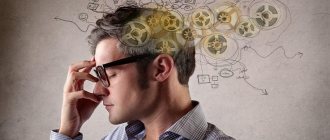| If you have discovered some of the described symptoms, this may indicate the development of a mental disorder. In this case, it is worth contacting a psychiatrist for diagnosis and initiation of timely treatment. In addition to face-to-face appointments , we offer a remote consultation service (online) , which is not inferior in quality to a personal meeting. Thus, you can receive qualified assistance from a high-level specialist, no matter where you are. |
Accompanying signs of the disease are: fear of self-worth, an oppressive feeling of emptiness (arising from difficulty in self-identification: what are my values, what do I believe in, what gives me pleasure), self-inflicted bodily wounds and dangerous behavioral patterns.
Derealization and depersonalization
Before determining the principles of treatment, specialists try to find out the mechanisms of functioning in as much detail as possible, as well as carry out diagnostic measures, including the following aspects:
- Consultation with a psychologist
- Conversation and comprehensive examination by a leading physician.
Treatment, as a rule, is prescribed comprehensively, which includes the use of medications, as well as psychotherapeutic work. All events are selected on a strictly individual basis.
The work of a psychologist primarily involves identifying the main reasons for which derealization-depersonalization manifests itself, as well as obtaining situational control of the situation and the symptoms displayed. Among the main and most common methods of therapeutic intervention are the following:
- Cognitive-behavioural
- Psychodynamic.
Regarding drug therapy, the most effective drugs are prescribed only after an individual examination. They are prescribed after identifying the reasons that could cause derealization-depersonalization. There are no specific medications in pharmaceuticals that could suppress the side symptoms of the disease.
When derealization or depersonalization occurs, the patient often begins to experience an overwhelming feeling of fear. However, all pathological manifestations can be effectively corrected.
Personality depersonalization syndrome
A distinctive characteristic of personality depersonalization is the inadequate perception and pathological perception of the individual’s own self. As a result, the patient ceases to feel like a person due to the occurrence of disturbances in the ongoing mental processes. As the disease develops, the individual’s personality begins to split into two halves: one takes an observational position, and the other takes an active position.
The first part functions in an isolated manner, that is, all the actions that the individual performs are not consciously realized. As a rule, a person thinks that the performance of any functions is carried out by external factors or other members of society. In addition, he is not able to perceive his own voice, physical body, but believes that they relate to another person. At the same time, the patient is able to express an objective opinion and sense reality.
It is important to note that the manifestation of a pathological syndrome cannot in every case be considered a mental disorder. Episodic phenomena, according to statistical data, occur in 70% of observed cases. They manifest themselves in the form of sensations when a person does not belong to himself or is not able to adequately assess the real world over a short period of time. In addition, even when systematic disorders occur, depersonalization cannot be equated with a mental disorder, since many people periodically experience a state as if the events that are happening are not happening to them, but to someone else.
Pathology includes only a stable state of mental illness or in the case when the symptoms are fixed in behavioral form for a long time.
Causes of the disorder
Genetic and psychogenic factors contribute to the development of antisocial personality disorder. The mechanism of development of impulsivity and aggression towards others may be associated with the pathological functioning of the serotonin transporter gene. The hormonal apparatus of a person with sociopathy produces less serotonin, as a result of which he is not able to take the necessary emotions from communication and experience empathy.
Sociopathy is five times more common in close male relatives than in other relatives. In families of patients with dissocial personality disorder, hysterical disorders are often detected. High criminal activity of family members, the presence of relatives suffering from alcoholism and drug addiction, poverty and unfavorable social conditions are also considered as factors contributing to the development of dissocial disorder.
The presence of mental illness in close relatives increases the risk of the disorder in children. In this case, a role is played by hereditary predisposition and adoption of behavior patterns from parents (quarrels between family members, violence, divorce of parents), and much also depends on methods of education (if relatives neglect the child, use violence, are inconsistent in discipline, etc.).
The cause of sociopathy, like other personality disorders, can be a lack of parental love and care in childhood, which leads to a lack of trust in people. A person with such experience is emotionally alienated and is able to establish contact with other people only through force. In some cases, family members may unknowingly instill in a person an antisocial behavior pattern - they give in to the child in order to maintain a good relationship, in response to his aggressive behavior or stubbornness. Excessive guardianship or neglect can also have an impact.
People with antisocial disorder have difficulty accepting points of view that differ from their own. Research has shown that people with this disorder are often less anxious than other people. Individuals with antisocial disorder have been found to be less able than controls to solve laboratory tasks, such as finding the way out of a maze, where the key reinforcers are punishments, such as some form of shock or monetary fine. When punishments were made more explicit or the subjects paid attention to them, learning improved. It is difficult for a person to learn from his mistakes, this may be due to the lack of an element that is key in the learning process.
Scientists have found that subjects with this disease react to the anticipation of stress with low brain arousal (slow arousal of the autonomic nervous system, low-frequency EEG waves). Due to low brain arousal, patients may find it difficult to perceive threatening situations, so they have little impact on them. Perhaps this is why antisocial and risky activities attract people, satisfying the need for more excitement.
Symptoms and signs of depersonalization
Manifestations of depersonalization include the following symptoms:
- A feeling of confusion, the individual does not understand what is happening in his life and the world around him
- Feeling separate from yourself and the world around you
- Inadequate perception of the surrounding world. It can be perceived as drawn, unreal, fantastic
- The presence of an insurmountable barrier between the patient and society
- Parts of one's own body may be perceived as foreign. So, for example, a person may feel his hand as artificial, and an inadequate perception of shapes and sizes occurs. There are often complaints that the patient is unable to control his own body
- There is a decrease in intellectual activity
- Decreased emotional response. The patient is not able to experience deep feelings, there is a monotony of responses to ongoing events, or they are completely absent
- Often a person feels helpless, abandoned or lonely
- Lack of appetite, or the patient is unable to get enough of even an excessive amount of food
- Disorientation in time space. Lack of perception of time of day
- Lack of perception of one's own body or current events.
It is important to note that with the stable development of the disease, symptoms can persist for several years without remission. However, the patient always has criticism, since he realizes that his condition is inadequate, which causes burden, despondency and depression.
If manic-depressive psychosis is observed, specialists do everything possible to get rid of such a condition, and also try to identify a pattern: which illness arose in the first place.
Treatment of personality depersonalization disease
The treatment process is selected individually in each case, taking into account the patient’s specific reactions and the characteristics of the body’s functioning. Includes drug therapy and work with psychotherapists. Medicines are prescribed only after determining the causes of depersonalization and a diagnostic examination.
Emotional depersonalization
A type of depersonalization, which is characterized by a partial or complete loss of emotional perception and, as a result, a lack of reactions to current events. Sometimes they are expressed in a monotonous form, which is why people around them are not always able to understand the patient.
It is important to note that the loss of emotions extends not only to the positive spectrum (joy, love), but also to the negative aspects (bitterness, disappointment). The result is manic-depressive syndrome. Or a phenomenon called “psychic anesthesia” occurs. According to statistics, the emotional type of depersonalization occurs with the development of a disease of the third category. However, this does not exclude the possibility of development in other types of disorders.
Often the disorder manifests itself in people with heightened emotional reactivity. Previously expressed emotions are preserved in their memory: love for loved ones and friends, joyful moments, experiences. But now nothing evokes emotional responses. Works of art or music do not evoke past admiration or any thoughts. The person becomes indifferent to past activities and hobbies. The mood also cannot be classified into any category: neither negative nor emotional. The surrounding world does not cause any interest, because it loses its expressiveness in front of a person suffering from depersonalization.
With the somatic manifestation of the disease, pain may occur, food loses its taste, tenderness and touch no longer cause any emotional reactions. The disease also has a negative impact on intellectual activity, thinking and memory. After a short period of time, a person no longer remembers what goals and objectives he set for himself. And although the very fact of the events remains in the memory, it no longer has an emotional connotation.
In practice, the onset of mental anesthesia is diagnosed in adults (most often females) on the basis of a developing depressive state. In addition, such behavior can be a side effect of long-term use of prescribed psychotropic medications.
Autopsychic depersonalization
A characteristic feature of this type of depersonalization is a complete lack of awareness of one’s own “I”, and there is also no emotional component. Among the main complaints are the following: a person ceases to perceive his own thoughts, reactions to ongoing events and interactions with other people remain without emotion, and sometimes are completely absent.
Autopsychic depersonalization involves the loss of natural self-awareness, a sense of one’s own Self. All reactions come down to an automatic reaction. However, a person is aware of pathological changes, so there is no feeling that his consciousness is guided by higher powers. Despite the automaticity of all actions, a person fully understands that they are initiated by himself.
The development of pathological psychological anesthesia is also considered characteristic, since a person completely and to a greater extent loses any kind of emotional response (positive or negative). Similarity of reactions is found regardless of the situation. As a rule, most patients worry precisely because of the loss of emotional response.
All events and experiences are perceived as if they were happening to another person. The patient begins to observe the ongoing changes and events from the outside, taking the passive side. When the condition seriously deteriorates, the personality splits into several components. There is a feeling that someone else lives in a person besides him. Inconsistency in actions, reactions, and different ways of thinking appear.
This form of the disease is also characterized by panic and anxiety, which arises as a result of awareness of a mental disorder that has a destructive role in his life. There is also a reverse reaction, when a person does not want to admit the fact of the presence of a disease, as well as spreading pathological forms. Most often this happens due to the fear that the person is beginning to lose consciousness.
In psychiatric practice, one can often find another development of the situation when the disease proceeds more smoothly. The disease progresses gradually, without sudden jumps. Among the most common complaints of patients is the loss of their own self, and there is also a feeling that the person is becoming a similar copy of himself and observing his life from the outside.
Since autopsychic depersonalization causes serious damage to the emotional sphere and normal communication with other people, the patient often begins to minimize contact with relatives and friends. There are difficulties in remembering which activities were favorite; often a person can freeze in one groove for an indefinite period of time.
A severe form of the disease most often occurs in patients suffering from other mental disorders, for example, schizophrenia and cerebral pathologies.
Depersonalization of VSD
Among the main symptoms of the development of depersonalization in VSD, the following aspects can be distinguished:
- Getting insufficient oxygen
- Prevalence of depression
- Temperature increase
- Dizziness occurs frequently
- Migraines of varying degrees of intensity.
As a rule, the development of dystonia often provokes a feeling of constant fatigue and weakness. In addition to complaints of impaired self-awareness, pain in the limbs also occurs. Most patients who have suffered from VSD for more than a year react especially acutely to weather changes.
The principles of treatment depend on the degree of development of the disease. Most often, inpatient treatment is carried out if uncontrollable fear develops, not a single medication helps in the fight against migraines, and self-control does not bring any results. In a critical situation, specialists can prescribe strong antipsychotics, sedatives, and tranquilizers.
To enhance the positive effect of treatment, it is also recommended to use additional therapeutic methods:
- Completion of complex massage activities
- Physiotherapeutic activities
- Acupuncture
- Use of antidepressants.
No less important is working with qualified psychologists who are able to help the patient solve the problem, stabilize his condition, and also find out the main causes of depersonalization.
Somatopsychic depersonalization
According to the theory of Yu.L. Nuller, somatopsychic depersonalization most often begins to develop in the initial period of the disease in its acute form. Among the most characteristic side symptoms that patients most often complain about is the lack of sensation of their own body or individual parts. Often ideas arise that the arms or legs have changed their shape or size.
Often the patient has the idea that he is missing clothes, they do not feel their touch on the body. However, objective sensitivity is not diagnosed, since the person continues to feel pain signals and the touch of another person. But the process takes place detachedly without any emotions. In addition, no physiological changes are detected in the limbs. Despite the fragmentation in their own sensations, patients understand reality and that their body has remained unchanged in shape.
The manifestation of a somatopsychic type of disorder can also include an absolute loss of the feeling of hunger or satiety. This is due to the fact that the previously most favorite dish no longer gives any satisfaction or positive emotions, so often a person becomes completely indifferent to eating and most often completely forgets to eat at the appointed time. As a result, not only the cyclical functioning of the body is disrupted, but side diseases associated with the functioning of the gastrointestinal tract may occur.
It is important to note that fulfilling any biological needs does not bring any satisfaction or relief, so often the patient begins to remember the need to perform some action when absolutely necessary, when the body begins to give signals.
For example, when taking a bath, complaints often arise that a person does not feel moisture on his skin or whether the water is used: hot or cold. Often the patient is not able to determine whether he has slept, since the feeling of rest is constantly absent. When visiting a psychotherapist, some people claim that they have gone without sleep for six months.
Somatic disorders cannot be avoided. Most often they are expressed in painful sensations in the back, spine, and headaches of varying intensity. At the slightest suspicion of depersonalization, the patient is subjected to a competent and comprehensive examination, since if the diagnosis is not dealt with, this can lead to the appearance of hypochondriacal delusions and split personality.
The way out of the emotional hole
Stage one. Contact a specialist
If you are already in a bad low-energy state, then you need the help of a professional, or maybe medicinal “crutches” for your psyche. So it’s best to sign up for a session with a psychologist or even a psychotherapist who will give the necessary recommendations. Well, even just speaking out, and, if you’re lucky, finally crying at the reception is already a huge relief.
Stage two. Establishing a daily routine and routine
Many people neglect proper nutrition, do not rest as much as they need, forcing their body to work for wear and tear. But people are not robots, and our bodies require certain care: nutrients, quality sleep, hardening.
To start feeling emotions, eat right: try to make your menu balanced and varied. Your table should include meat and fish dishes, vegetables, fruits, dairy and fermented milk products, nuts and dried fruits. And less fast carbohydrates - they give only a temporary boost in energy, and when it drops sharply, you feel even worse.
Play sports. Yes, despite the lack of strength. If you manage to overcome yourself in this matter, you will improve your will, get positive changes in your appearance, and improve your health. Everywhere you look there’s a lot of benefit. But the main thing is that after some time you will really get involved and begin to get a real buzz from the classes.
Get enough sleep. Give your body enough sleep, don't spend half the night on the Internet in vain attempts to escape from reality. Decide what time you will go to bed and get up, and stick to it. Within a couple of weeks you will notice how much better you feel.
Stage three. Getting to know yourself
If we relieved stress through the first two stages, now is the time to reacquaint ourselves with our emotions. So the first thing you have to do is allow yourself to feel. You can even draw a manifesto poster “I allow myself to feel.”
Second, keep a diary of emotions, in which throughout the day you note your reactions to certain situations. Each week, review your past entries and notice the expansion of your emotional range.
Third, at least once a week, delight yourself with new impressions, activities that break the usual home-work-home pattern. Do you love art? Go to a museum. Interested in dancing? Attend an introductory dance studio class. Come up with and write yourself a plan for the month that you will follow if you suddenly lack inspiration.
What's the result?
If you do not neglect any of the stages, you will not only safely get out of stress, but also experience the fullness of life again. Only in this way, as a whole, can you regain the ability to experience emotions and make the world sparkle again with its usual colors that delight the soul.









